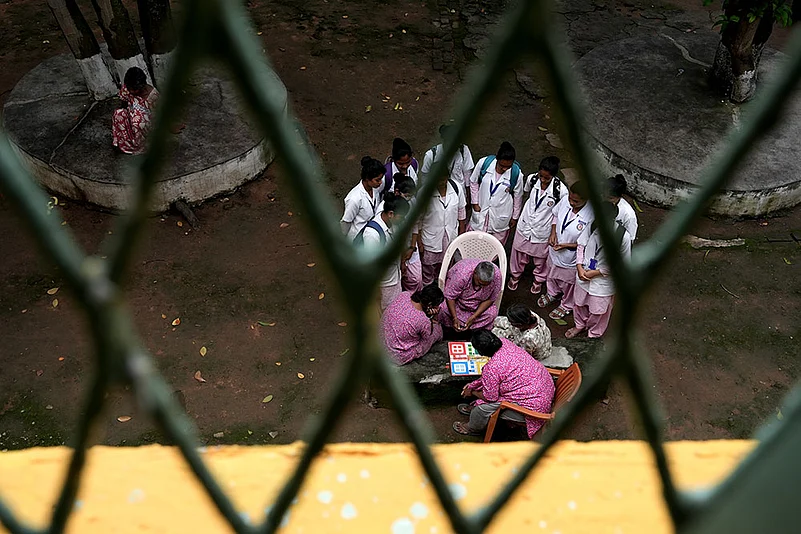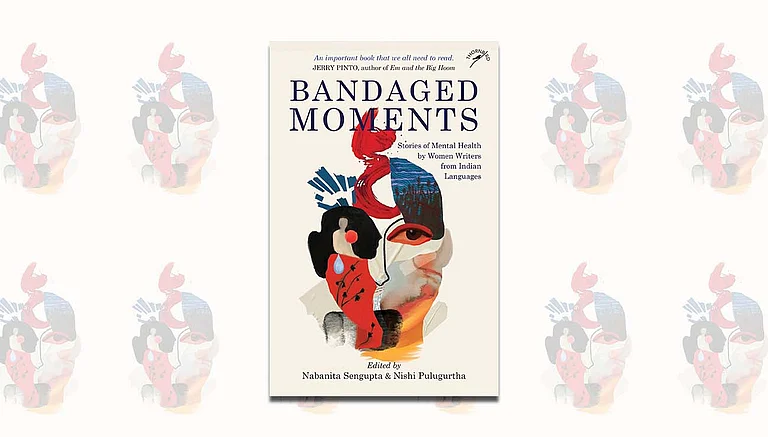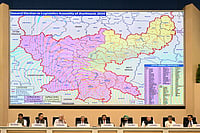
A look within the female section of the Ranchi Institute of Neuro-psychiatry.
A 40-year-old homeless woman from Bengal brought to RINPAS in 2016.
Diagnosed with psychosis, she, like many others, awaits family to come get her.
Inside the female section of the Ranchi Institute of Neuro-Psychiatry and Allied Sciences (RINPAS) in Kanke, 10 km from the Jharkhand capital, a woman who claims she won many singing competitions in school is singing in Bengali. “The earth is my home, don’t bind me here,” she explains the lyrics in Hindi. “Let me live freely… I want to live. I want to fly.”
The 40-year-old from West Bengal—let’s call her Sunita—was found to be homeless and brought here by the authorities in 2016. Diagnosed with psychosis, a condition marked by disconnection from reality, Sunita has been waiting all these years for her kin to come and take her away.
Now I can sense why something said to me in jest in childhood—“he has become majua, send him to Kanke”—always had that edge. People in our village would say this every time I got too stubborn or persistent, and I would invariably flare up as I knew the reference was to those whom society considered to be “abnormal”.
Nearly two and a half decades later, I am at the very place where they had threatened to send me, surrounded by many who had “become majua”, so to speak, and landed inside the walled compound in Kanke that houses RINPAS and the Central Institute of Psychiatry (CIP)—with pain, restlessness, sadness and a desperate search for family in their eyes.
Sharing this search she has clung to for the past seven years, with every unfamiliar face she meets, is a 25-year-old woman—let’s call her Priya—in RINPAS’s female section. She recites her home address in a single breath, names her parents and brothers, and begs to be taken home.
Soon her mood shifts and she begins singing songs in Santali (the most widely spoken language in the Munda subfamily of the Austroasiatic languages, related to Ho and Mundari), Nagpuri (Indo-Aryan language primarily spoken on the Chotanagpur plateau) and Hindi.
“There are two trees—a mango tree, a tamarind tree,” Priya says, explaining a Santali song. “Birds sit on both, and they cry every day when they see me. I tell them, ‘Don’t cry looking at me. My husband is very far away.” As she continues singing, four women leave the game of ludo they were playing on a platform outside ward no. 1 and gathered around Priya. Gradually, more women emerge from the ward. At their request, Priya sings songs from her favourite movies starring Kajol and Shah Rukh Khan, and then recites the following poem:
“If you want to pluck a flower, ask the government.
If you want to love me, ask my father.
The colour of henna appears only after it dries,
And I remember you only after I lose you.
Don’t pluck a bud—it will bloom;
Don’t break a heart—we’ll meet again.”
Over the years, Priya has become a beloved presence in the female section, giving hundreds of inmates a reason to smile, including Sunita, who had never imagined her devastating domestic trauma would leave her behind these walls. When her husband abandoned her, Sunita returned to her maternal home, but found no peace there.
“My three brothers and their wives constantly fought over me as they didn’t want me in the house,” she recalls. “Watching them quarrel every day, one day I simply left. But, now, I want to go home. My mother is looking for me. My brother is calling me back.”
Spread across 250 acres, the location of RINPAS was chosen for its pleasant climate. Founded over a century ago, the hospital has a fascinating history. After World War I, on May 17, 1918, a mental hospital—initially called the “European Lunatic Asylum”—was established in Kanke for psychologically affected soldiers and Anglo-Indians, but Indians were not allowed.
Then, on September 4, 1925, the “Indian Mental Hospital” was set up just a kilometre away. After independence, the Indian government renamed the former as the CIP, which now spans 210 acres, and the latter first as the Ranchi Mansik Arogyashala, and later, on January 10, 1998, as RINPAS.
“Nearly 600 patients have been discharged after receiving vocational training, but many others in manageable condition cannot be allowed to leave due to being unidentified”
While the central government manages the CIP, RINPAS is an autonomous body. Treatment at both is entirely free, and their reputation draws patients not only from Bihar, Jharkhand, Odisha, Bengal and Chhattisgarh, but also from Bangladesh, Bhutan and Nepal. Of nearly 600 inmates at the CIP, however, only about 125 are women, while RINPAS has nearly 600 inmates, including over 200 women, in its eight male and three female wards.
Despite the National Mental Health Survey of India (2015–16) reporting that women experience mental illness at higher rates than men, their hospital admission numbers are disproportionately low. Of the 1.1–1.5 million and 65,000–70,000 patients at the CIP and RINPAS’s annual OPDs, respectively, only 25,000–30,000 are women.
Siddharth Sinha, a psychiatrist at RINPAS for the past 13 years, believes stigma around mental illness that shackles society even today is one of the biggest obstacles to treatment. “There is also a stigma around psychiatric medication, with many myths regarding side effects,” says Dr Sinha, who also uses social media to combat the myths.
“Women, especially, face misconceptions. I have seen cases where their families stopped treatment to marry them off. When their condition worsens later, or the husbands realise something is wrong, they are brought back here. This often leads to broken marriages.”
According to Sinha, mental illness is just like physical illness and should be treated without fear or shame. Early detection, he says, is critical, as it saves lives by preventing depression, anxiety and psychosis from worsening.
Many families, however, treat the facilities not as treatment centres, but as dumping grounds, claim the staff and doctors. Even after inmates recover, their kin often don’t turn up, not even for a visit. Women bear the brunt of this abandonment.
The institute’s director, Amol Ranjan Singh, however, believes the stigma around mental illness has gradually reduced. “In 1997–98, we saw 8,000 OPD patients a year. Now, it’s nearing a lakh,” he says. “This doesn’t mean the incidence of mental illness is rising. Instead, it means awareness is rising. People now know mental illness is treatable, and that it could affect anyone regardless of class, caste or education.”
In fact, Urdu poet Majaz and revolutionary Bengali poet Kazi Nazrul Islam were admitted here in the 1950s, as was Vashishtha Narayan Singh, the noted mathematician who struggled with mental health. “We must remove the myths and shame surrounding this. Early detection and timely treatment are key,” adds Singh.
For those whose conditions respond to medication, RINPAS offers vocational therapy and rehabilitation, such as training in tailoring, carpentry or printing, so inmates can earn a living after leaving the facility. Yet many women who have been trained for years are still inmates, and their first question to the doctors doing the rounds is always: “When can we go home?”
There is a 36-year-old inmate, though, who no longer wishes to return home. Sitting in a corner of the vocational centre and weaving a shawl, the devotee of Lord Shiva—let’s call her Parvati—is calm. Though she began learning the skill just two years ago, it seems she has been practising for decades as she can weave a shawl measuring two metres by one in just a week.
Focusing intently, she says she studied till Class 9, loved science and attended a school named “National University”. “I wanted to understand people, who they are, what they would say to me. That’s why I liked science,” she says. When told that she means psychology perhaps, Parvati smiles and says, “Psychology is science, isn’t it?” Parvati is an inmate because she was diagnosed with psychosis.
Others, too, have made shawls, sweaters, caps and tablecloths, and take pride in the praise and small incentives they receive in return.
Ward no. 2 of the male section feels like an “asylum scene” from an old film—someone talking to himself, another holding utensils by the window, and someone else staring through the mesh grills. Suddenly, a 26-year-old—let’s call him Pritam—walks up to me and touches my feet—because of the grey in my beard, he later explains.
“Take respect, give respect…nice to meet you, sir,” he says. “My uncle is a DSP (deputy superintendent of police), another is an IGP (inspector-general of police). I studied at IIT Bombay. I’m a software engineer. I was in Kashmir with the Border Security Force. My aunt died, so sometimes I cry. Why should I share my sadness with anyone? I met Shah Rukh Khan. I’m worth Rs 70 lakh. I was also a mind doctor in America.”
Pritam says he ended up inside because he used to “smoke brown sugar (heroin)-laced cannabis”, which the doctors diagnosed as “multiple substance dependence”. “I was so paranoid and depressed, I dreamed my girlfriend got pregnant and set herself on fire,” recalls Pritam. Media reports claim around 1,000 de-addiction patients are admitted at RINPAS annually.
Three months ago, a 45-year-old man diagnosed with schizophrenia—let’s call him Arif Ansari—was brought in by his brother. Arif talks to himself, hears loud voices and believes they are ghosts. He insists a jinn has been inside him since 1996 and asks it to leave. Though doctors say he is now well enough to go home, his kin refuse to take him back. When the staff call his brother, he blocks their number.
RINPAS has two kinds of patients—the homeless picked up by the police, and others brought in by their kin. It is mostly the former who stay long-term. Hospital protocol requires families to take the inmates back within three months—the period that doctors estimate as necessary for 60–70 per cent recovery—as the rest of the recovery depends on care at home. In most cases, though, the kin never come back, forcing the administration to begin pressuring them to comply.
“Nearly 600 patients have been discharged after receiving vocational training, but many others in manageable condition cannot be allowed to leave due to being unidentified,” says P.K. Singh, who teaches at RINPAS, which offers a postgraduate programme in psychiatry. The CIP produced India’s first MD in psychiatry, L.P. Verma.
Author Ashwini Kumar Pankaj writes that RINPAS and the CIP never treated patients like “mad people” but as regular patients. Patients performed plays, played football and hockey, and even hosted music programmes. During 1925–29, the hospital team beat all local clubs in Ranchi in tournaments, and in 1940 alone the inmates watched 58 movies—in Hindi, English and Bengali.
(Some names have been changed to protect identities.)
MORE FROM THIS ISSUE
Md Asghar Khan is senior correspondent from Jharkhand.
In its August 21 issue, Everyday I Pray For Love, Outlook collaborated with The Banyan India to take a hard look at the community and care provided to those with mental health disorders in India. From the inmates in mental health facilities across India—Ranchi to Lucknow—to the mental health impact of conflict journalism, to the chronic stress caused by the caste system, our reporters and columnists shed light on and questioned the stigma weighing down the vulnerable communities where mental health disorders are prevalent. This copy appeared in print as When Will I Go Home?






































